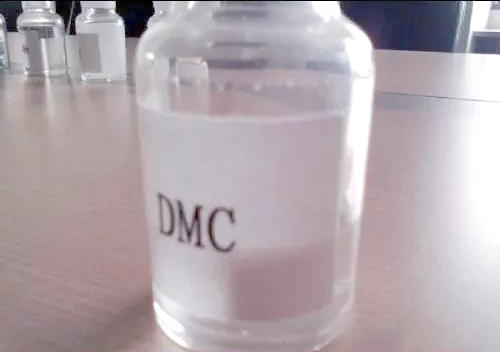Dimethyl carbonate ( DMC), linear formula C3H6O3, molecular weight 90.08, at room temperature is a transparent liquid, slightly fragrant. Difficult to dissolve in water, but can be miscible with alcohols, ketones, esters and other arbitrary ratio. Dimethyl carbonate is a kind of low toxicity, environmental protection performance, wide range of chemical raw materials, is an important organic synthesis intermediates.DMC in the production of safe, convenient, less pollution, easy to transport, etc., known as the "DMC".
DMC widely serves in pesticides, pharmaceuticals, spices, fuel additives, solvents, and the electronics industry.
Before 1980, DMC production basically used the phosgene method, which uses highly toxic raw material phosgene, by-production of a large number of corrosive hydrochloric acid, not only pollute the environment, and the residual chlorine affects the quality of the product, which has now been eliminated.
From the 1970s, major foreign companies began the research and development of non-photogas route to synthesize DMC, of which the Italian company Enichem was the first to develop a successful methanol liquid-phase oxidation carbonylation synthesis of DMC new technology, and in 1983 built 5500t / a device, the world's first to achieve the industrialization of DMC non-photogas route. Due to the technical monopoly of Enichem, other countries had to research and develop their own DMC non-photogas synthesis technology and application development.
In 1988, the U.S. DOW Chemical Company successfully developed the gas-phase synthesis of DMC, which replaces the highly toxic dimethyl sulfate as a carbonylating, methylating, and methoxylating agent.
MC, a better solution to the corrosive liquid-phase method, the product recovery is more convenient, but has not been able to find the ideal catalyst to solve the problem of its selectivity is significantly lower than that of the liquid-phase method, and the loss of catalyst components is serious.
In the early 1990s, Japan's Ube Company drew inspiration from its dimethyl oxalate synthesis process and successfully developed an economically feasible low-pressure non-homogeneous process route. In 1992, the company built a 3,000 t/a production unit. The shortcoming of this process is the by-production of dimethyl oxalate with poor selectivity.
Texaco (USA) developed another non-photogas process, the transesterification process, which uses derived propylene carbonate as an intermediate. In the presence of a catalyst, propylene carbonate undergoes transesterification with methanol, enabling the co-production of DMC and propylene glycol.

There are many existing synthesis methods for dimethyl carbonate, which are mainly divided by raw materials: phosgene methanol method, phosgene sodium alcohol method, methanol ester exchange method, direct carbon dioxide synthesis method, direct alcoholysis of urea, indirect alcoholysis of urea, and oxidized carbonyl method of methanol.
Diphenyl carbonate:Used in the synthesis of polycarbonate (PC), in addition, also widely used in solvents, plasticizers, pesticides and pharmaceuticals and other industries. The traditional method of producing diphenyl carbonate is the phosgene method, which is facing elimination due to environmental issues. The mainstream non-photogas synthesis route is the ester exchange of dimethyl carbonate with phenol. The ester exchange method has the advantages of high product quality and good technical economy.
Methylenebis (phenylisocyanate) (MDI):Organic isocyanate is an important class of compounds, in the synthesis of polyurethane, coatings, dyes, leather, pesticides and other materials, has a wide range of applications. Organic isocyanate is one of the main raw materials for the manufacture of polyurethane (PU for short), which is an organic compound containing an isocyanate group (-NCO) in the molecule, with the general formula R(NCO).
PU products prepared by it in the elasticity, abrasion resistance, elongation, etc. than other isocyanates as raw materials for PU products with superior performance, widely used in microporous elastomers, thermoplastic elastomers, casting elastomers, synthetic leather, adhesives, coatings, sealants and other manufacturing. Among several isocyanate synthesis methods, dimethyl carbonate amine solution method has a strong competitive advantage.
Hexamethylene Diisocyanate (HDI):HDI is an important aliphatic diisocyanate varieties, with low density, high strength, good thermal insulation properties, flame retardant and heat-resistant properties better than other types of plastics, processing and molding is simple, according to the needs of adjusting the formula, you can get different densities of different soft and hard polyurethane products. It plays an increasingly important role in aviation, textile, foam, plastic, coating and rubber industries.
Compared with aromatic polyurethane coatings, aliphatic polyurethane coatings made from HDI resist yellowing, preserve color and gloss, prevent chalking, and offer oil and wear resistance. As a result, they are an essential component in high-grade coatings. Compared with aromatic isocyanate, HDI is more difficult to prepare, higher prices, but its outstanding light stability and weather resistance is remarkable, so HDI is a new synthetic material in the world is developing very rapidly.
As an indispensable intermediate for organic synthesis, dimethyl carbonate is widely used in production due to its diverse reaction properties, including safety, ease of operation, low environmental impact, and convenient transportation.Below we will discuss several major uses of dimethyl carbonate in depth:
In chemical synthesis, dimethyl carbonate plays an important role as a methylating agent and carbonylating agent, and it is involved in the preparation of pesticide herbicides, such as as an intermediate of sulfentrazone. In addition, it plays a key role in synthesizing polycarbonate, diphenyl carbonate, isocyanate, and allyl diethylene glycol carbonate using the non-photogas method.
Dimethyl carbonate plays a key role in synthesizing various carbamate pesticides, such as carbaryl, and serves as an essential intermediate in producing anisole, benzene dimethyl ether, alkyl aryl amines, symmetrical diaminoureas, hydrazinyl formic acid methyl ester, and other compounds.
In the pharmaceutical field, dimethyl carbonate plays a crucial role in preparing amino oxazolidinone, ciprofloxacin, β-keto carboxylic acid esters, and other pharmaceutical intermediates
Dimethyl carbonate enhances fuel performance as an additive in gasoline and diesel. At the same time, it has a wide range of applications in the manufacture of refrigeration machine oils and solvents.
In the melt polycondensation process, dimethyl carbonate synthesizes bisphenol-A-polycarbonate, further broadening its application in polymer materials.
In the food industry, dimethyl carbonate acts as an antioxidant and plant protection agent, playing a positive role in preserving and improving the quality of food.
In addition, dimethyl carbonate is an important solvent for lithium-ion battery electrolyte, as well as a solvent for specialty spices and intermediates, showing its potential in the field of new energy and fine chemicals.
Contact: Tony Li
Phone: +86-13263299644
Tel: +86-13263299644
Email: sales@ecoviaet.com
Add: No 3 Youyi Road,Tangshan,Huantai,Zibo,China
We chat
